Data Literacy Chapter Notes | Artificial Intelligence (AI) for Class 9 PDF Download
Introduction to Data Literacy
Data literacy refers to the ability to understand, work with, and communicate about data effectively. It involves the skills to collect, analyze, and present data in meaningful ways.
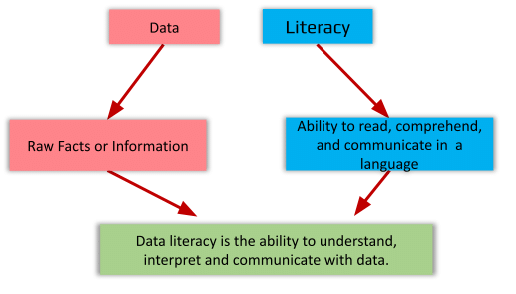
Data Pyramid
- The Data Pyramid consists of various stages of working with data, moving from raw data at the bottom to wisdom at the top.
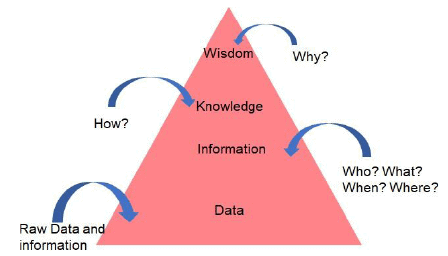
Moving Up the Data Pyramid:
- Raw Data: At the base, data is available in its raw form, which is not very useful on its own.
- Processed Data: Data is processed to extract information about the world.
- Information: This information leads to knowledge about how things are happening.
- Knowledge: Knowledge allows us to understand the reasons behind certain occurrences.
- Wisdom: At the top, wisdom helps us grasp why things are happening in a particular way.
Example - Traffic Light: The Traffic Light example illustrates the Data Pyramid concept, showing how raw data at the bottom can be processed and analyzed to gain knowledge and wisdom about traffic management.
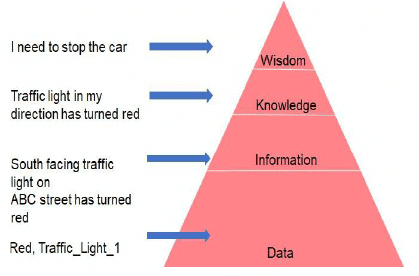
Impact of Data Literacy
How to Become Data Literate
Data literacy is the ability to read, understand, create, and communicate data as information. It involves being able to interpret data correctly and use it to make informed decisions.
Every dataset has a narrative, yet we must approach these narratives with caution before accepting them as truth. A data-literate individual is someone capable of engaging with data to gain insights about their surroundings.
Data literacy empowers individuals to research products effectively while shopping online.
Scenario: Purchasing a Video Game Online
When shopping online, data literacy plays a crucial role in helping people make informed decisions about products.
 Here’s how a data-literate person would approach this scenario:
Here’s how a data-literate person would approach this scenario:
- Filter the product category based on requirements. For instance, if the budget is limited, they would set the price filter from low to high.
- Check user ratings and reviews of the products to gauge their popularity and quality.
- Look for specific requirements in the product description to ensure it meets all necessary criteria.
Data Literacy Process Framework
The data literacy framework offers direction on utilizing data effectively and with varying levels of awareness. It is important to note that the data literacy framework is not a one-time process but an iterative one.
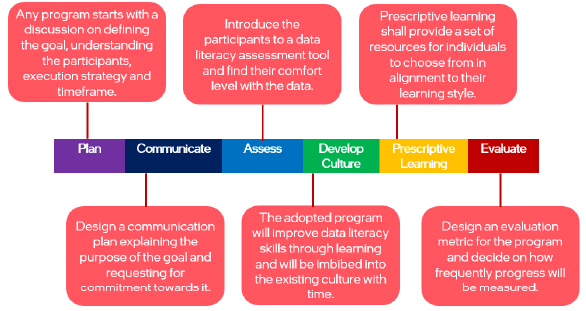
Data Security and Privacy in AI
Data Security and Data Privacy are terms that are often used interchangeably, but they have distinct meanings.
Understanding Data Privacy
Data Privacy, also known as information privacy, involves the proper handling of sensitive information, including personal data and other confidential information such as certain financial data and intellectual property. The goal is to meet regulatory requirements while protecting the confidentiality and integrity of the data.
Here are a couple of examples that illustrate situations which can compromise data privacy:
Importance of Data Privacy and Security
Data privacy and security are crucial because they protect individuals and organizations from various risks associated with mishandling data. Here are some key reasons why they are important:
- Prevention of Identity Theft: When personal data is not adequately protected, it can lead to identity theft, where malicious actors use someone else's information for fraudulent purposes.
- Protection of Sensitive Information: Organizations often handle sensitive information, such as financial records, health data, and trade secrets. Data privacy and security ensure that this information is kept confidential and secure.
- Compliance with Regulations: Many countries have strict regulations regarding data protection, such as the General Data Protection Regulation (GDPR) in the European Union. Non-compliance can result in hefty fines and legal consequences.
- Maintaining Trust: Businesses rely on the trust of their customers. If a company suffers a data breach, it can damage its reputation and lead to a loss of customer trust.
- Prevention of Financial Loss: Data breaches can be costly for organizations, leading to financial losses due to legal fees, fines, and remediation costs.
In summary, data privacy and security are essential for safeguarding personal and sensitive information, complying with legal requirements, maintaining trust, and preventing financial losses.
What is Data Security?
Data security refers to the practice of safeguarding digital information from unauthorized access, corruption, or theft throughout its entire lifecycle. This involves implementing measures to protect data at rest, in transit, and in use, ensuring that only authorized individuals have access to sensitive information.

With the increasing volume of data being stored and processed in the cloud, the risk of cyber threats has also escalated. Therefore, it is crucial to control and protect the transfer of sensitive or personal information at all stages.
The importance of data security has grown due to several factors:
- Widespread Impact of Cyber Attacks: Cyber attacks can affect individuals and organizations across various sectors, making data security a shared responsibility.
- Rapid Technological Advancements: As technology evolves, so do the methods and tools used by cyber criminals, necessitating stronger and more adaptive data security measures.
Best Practices for Cyber Security
Cyber security encompasses the protection of computers, servers, mobile devices, electronic systems, networks, and data from harmful attacks. To ensure effective cyber security, consider the following best practices:
- Regular Software Updates: Keep all software, including operating systems and applications, up to date to protect against known vulnerabilities.
- Strong Password Policies: Implement strong password policies that require complex passwords and regular changes. Consider using multi-factor authentication for added security.
- Employee Training: Train employees on cyber security best practices, including recognizing phishing attempts and safe browsing habits.

- Data Encryption: Encrypt sensitive data both in transit and at rest to protect it from unauthorized access.
- Regular Backups: Regularly back up data to ensure it can be restored in case of a cyber attack or data loss incident.
- Network Security: Implement firewalls, intrusion detection systems, and other network security measures to protect against unauthorized access.
- Incident Response Plan: Develop and maintain an incident response plan to quickly address and mitigate the impact of cyber incidents.
Do's for Online Safety
- Use Strong and Unique Passwords: Create passwords that are difficult to guess, using a combination of letters, numbers, and symbols for each of your accounts.
- Enable Two-Factor Authentication (2FA): This adds an extra layer of security by requiring a second form of verification in addition to your password.
- Download Software Safely: Only download software from trusted sources and always scan files for viruses before opening them.
- Look for Secure Websites: When entering personal information, ensure the website's URL starts with "https://" for a secure connection.
- Keep Your Devices Updated: Regularly update your web browser, operating system, and antivirus software to protect against security vulnerabilities.
- Adjust Social Media Privacy Settings: Modify your privacy settings on social media platforms to limit the visibility of your information to close contacts only.
- Lock Your Screen: Always lock your computer or device screen when you step away to prevent unauthorized access.
- Connect with Trusted Individuals: Only connect with people you trust online to reduce the risk of encountering harmful individuals.
- Use Secure Wi-Fi Networks: Avoid using public Wi-Fi networks for sensitive activities and opt for secure, private networks instead.
- Report Online Bullying: If you experience or witness online bullying, report it to a trusted adult immediately for assistance.
Things You Shouldn't Do
- Personal Information: Don't share personal details like your real name or phone number.
- Pictures: Avoid sending pictures to strangers or posting them on social media.
- Emails: Don't open emails or attachments from people you don't know.
- Suspicious Requests: Ignore any suspicious requests for personal information, such as your bank account details.
- Passwords: Keep your passwords and answers to security questions private.
- Copyrighted Software: Don't copy software that is protected by copyright without permission.
- Cyberbullying: Avoid engaging in cyberbullying or using offensive language online.
Acquiring Data, Processing, and Interpreting Data
Different Types of Data
Artificial Intelligence (AI) relies heavily on data, which serves as its foundation. Every day, we encounter various types of information. Here are some common types of data: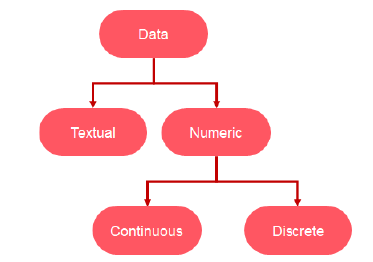
Textual Data (Qualitative Data)
- Textual data consists of words and phrases and is used for Natural Language Processing (NLP).
- Examples include search queries on the internet, such as "Which is a good park nearby?"
Numeric Data (Quantitative Data)
- Numeric data is made up of numbers and is used for statistical purposes.
- Examples include measurements, readings, or values such as a cricket score or a restaurant bill.
Numeric Data can be further classified into:
- Continuous Data: This type of numeric data can take any value within a range and is not restricted to specific separate values. Examples include measurements such as height, weight, temperature, and voltage, where the data can vary continuously.
- Discrete Data: Discrete data consists of numeric values that are whole numbers and cannot be expressed as fractions or decimals. For instance, the number of students in a class is a discrete figure because it can only be a whole number, not a fraction.
Types of Data used in Three Domains of AI
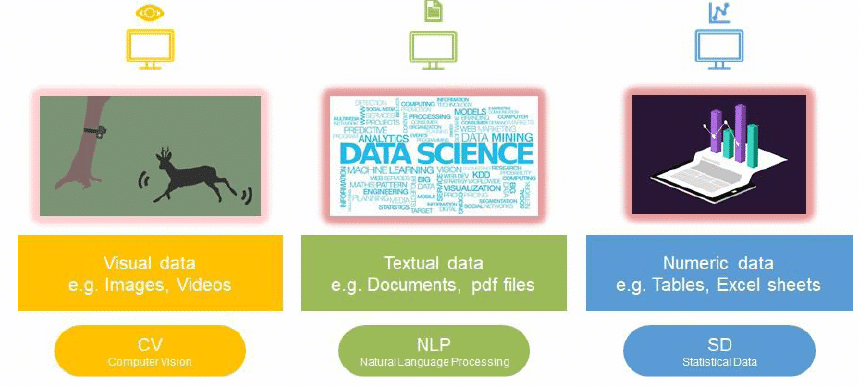
Data Acquisition / Acquiring Data
Data Acquisition, also known as acquiring data, involves the process of gathering data, which includes searching for datasets that are suitable for training AI models. This process typically consists of three main steps:
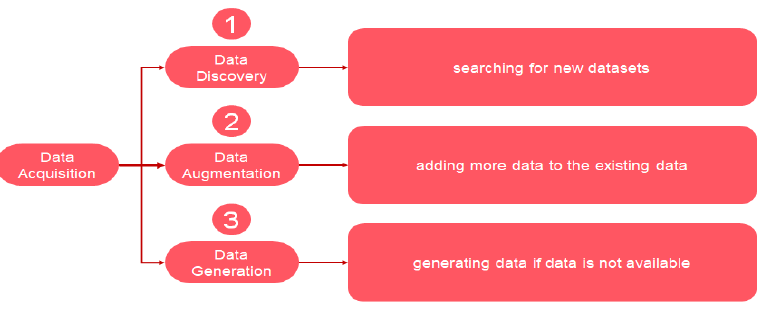
Acquiring Data - Sample Data Discovery
- Data discovery involves searching for and downloading data from the internet to create a computer vision model. For example, if we want to build a model for a self-driving car, we need images of roads and objects on roads.
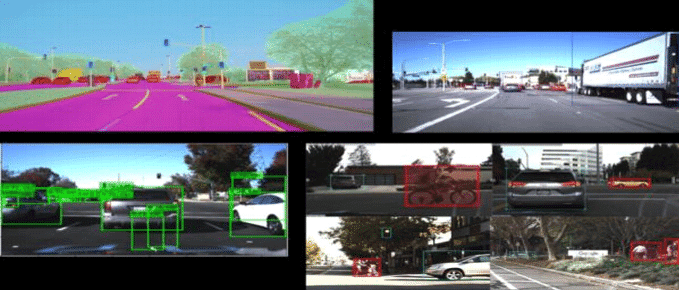
Acquiring Data - Sample Data Augmentation
- Data augmentation refers to the process of increasing the amount of data by making slight modifications to existing data. This can be done by altering parameters such as color and brightness of an image. By making these small changes, we can create new data from existing data.

Acquiring Data – Sample Data Generation
- Data generation involves creating or recording data using sensors or other means. For instance, recording temperature readings in a building is a form of data generation. The captured data is then stored in a computer in an appropriate format for further use.
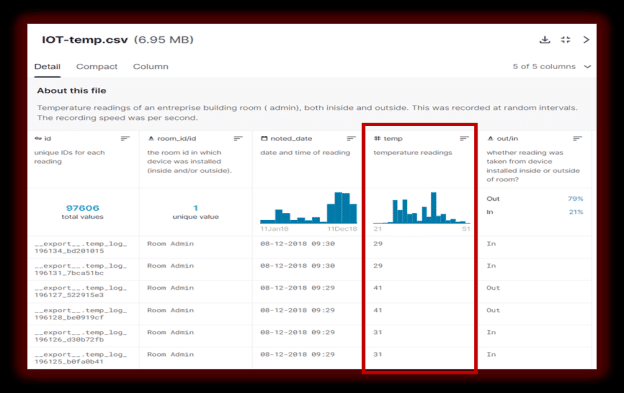
Sources of Data
Data can be acquired from various sources, which are broadly classified into primary and secondary data sources.
Primary Data Sources
- Primary data is collected firsthand through methods such as surveys, interviews, and experiments.
- For example, data generated from an experiment conducted in a classroom setting is considered primary data.
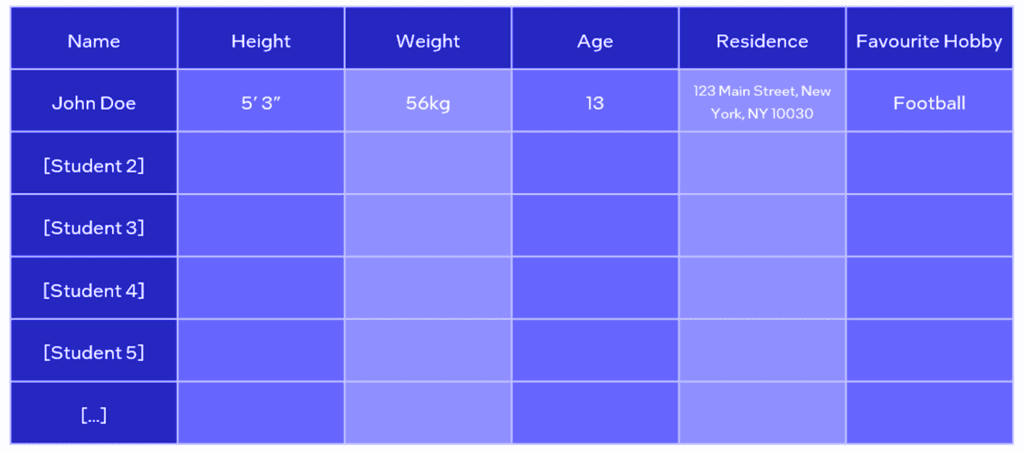
Secondary Data Sources
- Secondary data is obtained from existing sources rather than collected personally.
- Common sources for secondary data collection include research papers, articles, online databases, and government publications.
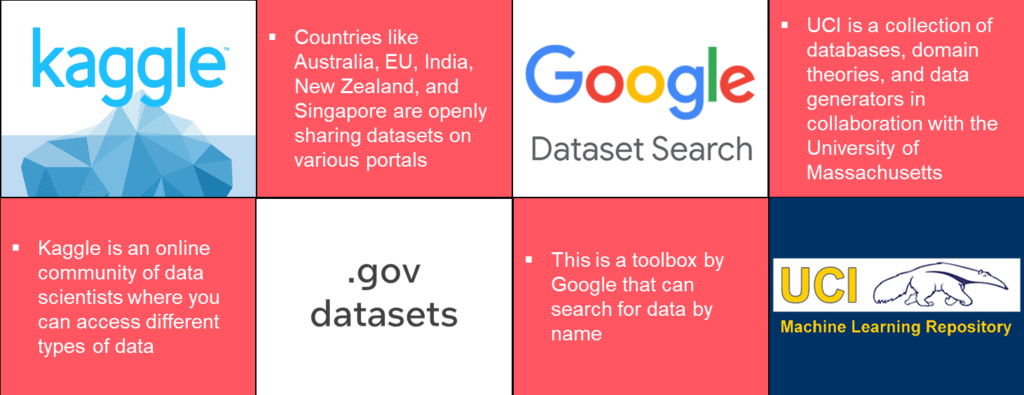
Best Practices for Acquiring Data
Checklist for Evaluating Data Quality
- Good Data: Data that is reliable, accurate, and suitable for analysis.
- Bad Data: Data that is flawed, incomplete, or not relevant, leading to potential issues in analysis.
Data Acquisition from Websites
When acquiring data from websites, ensure that the source is trustworthy and the data is relevant to your needs.
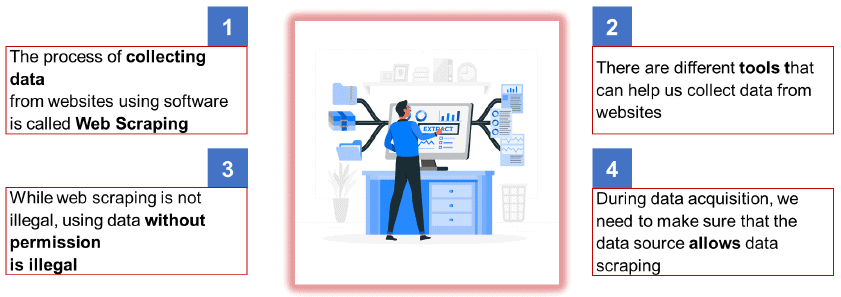
Ethical Concerns in Data Acquisition
- Be mindful of ethical considerations when gathering data.
- Address potential ethical issues proactively to avoid complications later.
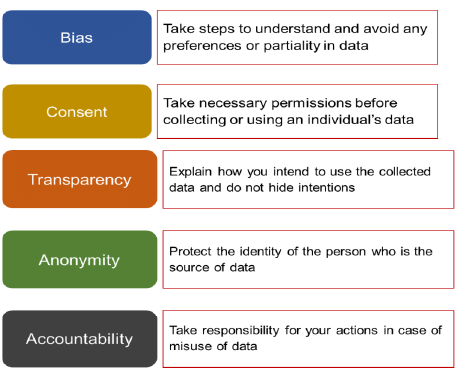
Features of Data and Data Preprocessing
Usability of Data
Factors Determining Data Usability:
- Structure: Refers to how data is organized and stored.
- Cleanliness: Clean data is essential for reliable analysis. It should be free from duplicates, missing values, outliers, and other anomalies. For instance, duplicates are removed during the cleaning process to enhance data quality.
- Accuracy: Accuracy reflects how closely data matches real-world values. It ensures that the data is reliable and trustworthy. Accurate data should closely resemble actual values without errors. For example, measuring the length of a small box in centimeters demonstrates the importance of accuracy in data collection.
Kaggle's Usability Scoring
- Kaggle evaluates and assigns usability scores to datasets based on user feedback.
Usability of Data
Usable Data Characteristics
Usable data is typically characterized by the following features:
- Relevance: The data should be relevant to the problem at hand.
- Accuracy: The data must be accurate and free from errors.
- Completeness: The dataset should be complete, with no missing values that could impact analysis.
- Consistency: Data should be consistent across different sources and over time.
- Timeliness: The data should be up-to-date and timely for the analysis.
Types of Features in AI Models
1. Independent Features
- Independent features, also known as input features, are the variables that the model uses to make predictions.
- These features provide the necessary information for the model to understand the context and make an informed prediction.
- For example, in a dataset predicting house prices, independent features might include the size of the house, the number of bedrooms, and the location.
2. Dependent Features
- Dependent features, or output features, are the variables that the model aims to predict.
- These features represent the outcome or the target variable in the dataset.
- Continuing with the house price example, the dependent feature would be the price of the house, as that is what the model is trying to predict based on the independent features.
Role of Features in AI
- Features play a crucial role in the performance of AI models.
- Well-chosen independent features can significantly improve the model's accuracy and ability to generalize to new data.
- Similarly, clearly defined dependent features help in setting the right goals for the model, ensuring it learns the correct patterns from the data.
Data Processing and Data Interpretation
- Data processing refers to the use of computers to perform various operations on data, helping to make sense of raw information. It involves organizing, analyzing, and transforming data into a more understandable format.

- Data interpretation is the process of extracting meaningful insights and answers from processed data. It involves examining the data to answer critical questions and make informed decisions based on the information presented.
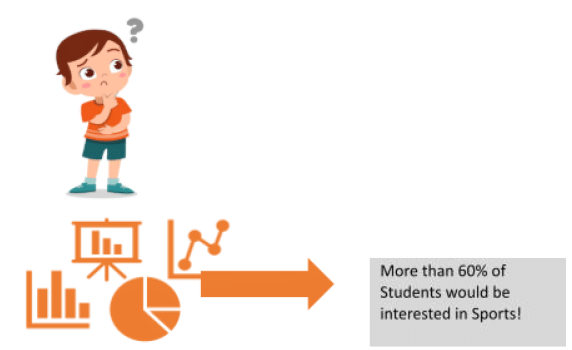
Keywords related to Data
- Acquire Data. This refers to the process of collecting data from various sources.
- Data Processing. After raw data is collected, it undergoes processing to extract meaningful information.
- Data Analysis. This involves examining each component of the data in order to draw conclusions.
- Data Interpretation. This is the ability to explain the significance of the findings or conclusions in a specific context.
- Data Presentation. In this step, ideas and evidence are selected, organized, and grouped logically for presentation.
Methods of Data Interpretation
Data interpretation is the process of making sense of data by analyzing and drawing conclusions from it. There are two main types of data: qualitative and quantitative. Qualitative data refers to non-numerical information that describes qualities or characteristics, while quantitative data involves numerical values that can be measured and analyzed statistically.Qualitative Data Interpretation
Qualitative data interpretation focuses on understanding the emotions, feelings, insights, and motivations of people. Here are some common methods used to collect qualitative data:
- Record Keeping: This method involves using existing reliable documents and sources of information to gather data, similar to researching in a library.
- Observation: In this approach, the behavior and emotions of participants are observed carefully to gather insights.
- Case Studies: Data is collected from in-depth case studies that provide detailed information about specific instances or situations.
- Focus Groups: Data is collected through group discussions on relevant topics, capturing diverse perspectives and opinions.
- Longitudinal Studies: This method involves repeatedly collecting data from the same source over an extended period to observe changes and trends.
- One-to-One Interviews: Data is gathered through individual interviews, allowing for in-depth exploration of specific topics or issues.
Quantitative Data Interpretation
Quantitative data interpretation involves analyzing numerical data to answer questions related to "when," "how many," and "how often." This type of data helps in understanding patterns, trends, and statistical relationships. For example, measuring the number of likes on an Instagram post falls under quantitative data interpretation as it involves counting and analyzing numerical values.
Methods for Collecting Quantitative Data
- Interviews: Quantitative interviews are crucial for gathering information.
- Polls:. poll is a specific type of survey that poses straightforward questions to respondents, typically limited to just one question.
- Observations: Quantitative data can be gathered through observations made within a specific time frame.
- Longitudinal Studies: This involves conducting a study over an extended period.
- Surveys: Surveys can be administered to a large number of individuals to collect quantitative data.
Steps for Analyzing Quantitative Data
- Relate measurement scales with variables
- Connect descriptive statistics with data
- Decide a measurement scale
- Represent data in an appropriate format
Qualitative and Quantitative Data Interpretation
Qualitative data interpretation focuses on understanding feelings and emotions, answering questions of how and why, and is gathered through methods like interviews and focus groups. For example, a qualitative question might ask why students enjoy online classes. In contrast, quantitative data interpretation provides insights into quantity, answering questions of when, how many, or how often, using methods like assessments, tests, polls, and surveys. An example of a quantitative question could be how many students like attending online classes.
Textual Representation of Data in Data Interpretation (Textual DI)
- Data is presented in textual form, typically within a paragraph.
- This method is appropriate when the data is not extensive and can be easily understood through reading.
- Textual presentation becomes unsuitable for large datasets.

Tabular Representation of Data in Data Interpretation (Tabular DI)
- Data is organized systematically into rows and columns.
- The title of the table, such as "Item of Expenditure," provides a description of the table's content.
- Column headings, including "Year," "Salary," "Fuel and Transport," "Bonus," "Interest on Loans," and "Taxes," describe the information contained in each column.

Graphical Representation of Data (Graphical DI)
- Bar Graphs: Bar graphs use vertical or horizontal bars to represent data. The length or height of each bar corresponds to the value it represents.
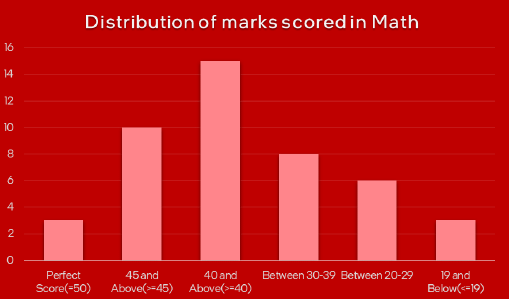
- Pie Charts: Pie charts represent data in a circular format, where the circle is divided into slices. Each slice represents a portion of the whole, with the size of the slice corresponding to the value it represents.
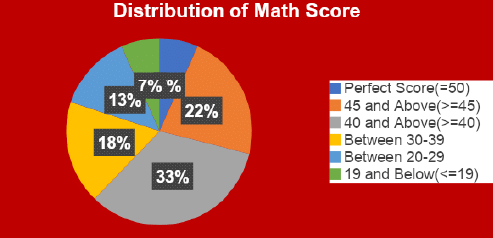
- Line Graphs: Line graphs display data points connected by lines. They are commonly used to show changes in quantity over time, with the x-axis typically representing time intervals and the y-axis representing the quantity.
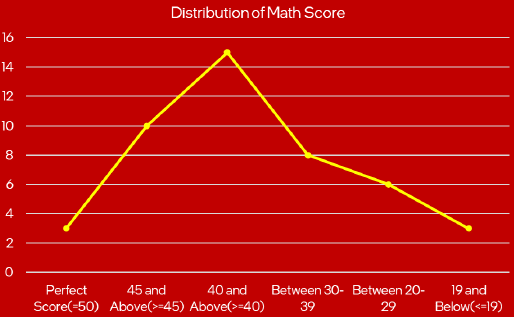
|
32 videos|57 docs
|
FAQs on Data Literacy Chapter Notes - Artificial Intelligence (AI) for Class 9
| 1. What is data literacy, and why is it important for individuals and organizations? |  |
| 2. How does data literacy impact decision-making in businesses? |  |
| 3. What are the key components of the data literacy process framework? |  |
| 4. Why is data privacy crucial in today's digital world? |  |
| 5. What are the main features of data preprocessing, and why is it important? |  |





















